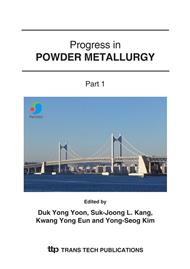p.629
p.633
p.637
p.645
p.649
p.653
p.657
p.661
p.665
Application Experiences in Powder Compaction of Iron Powder - Influence of Tool Material on Tool Life
Abstract:
Tool steels for powder pressing are normally heat treated to a high hardness to counteract plastic deformation during the compacting process. Ductility and wear resistance of the die punch or core rod are determined by the type, size, amount, hardness and distribution of the hard phase in the martensitic matrix. Thus, tool steels can be designed and optimized for specific powder pressing application. To be able to utilize the full potential of the tool steel, also the design, heat treatment and eventual surface coating of the steel must be taken into account. In this paper new low-friction tool steel is investigated in PM manufacturing for a number of applications. An increase of tool life of more than two times compared to ordinary tool steels is found. Furthermore, the new low friction tool steel shows a potential for sintered parts with higher densities through the applicability of increased compaction pressure or minimized lubricant amount.
Info:
Periodical:
Pages:
649-652
Citation:
Online since:
January 2007
Authors:
Keywords:
Price:
Сopyright:
© 2007 Trans Tech Publications Ltd. All Rights Reserved
Share:
Citation:


